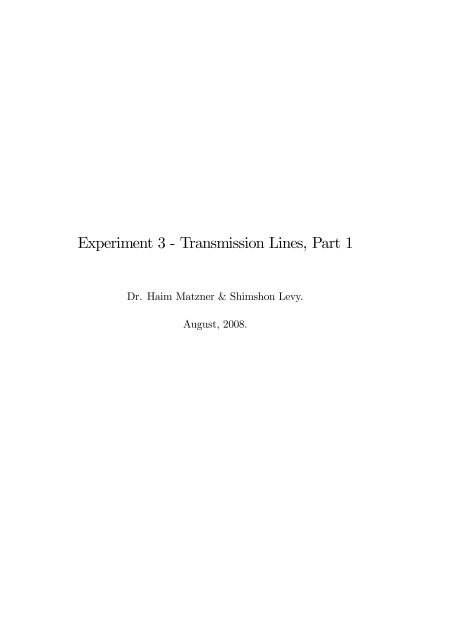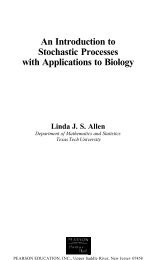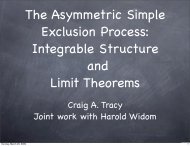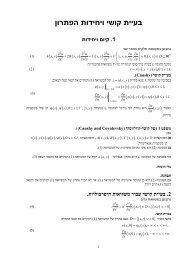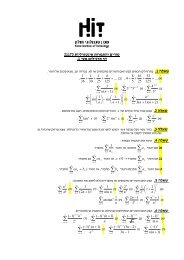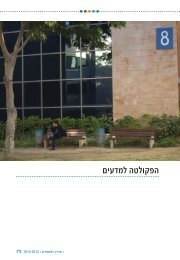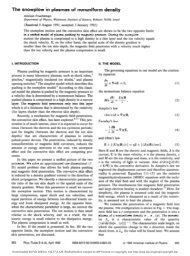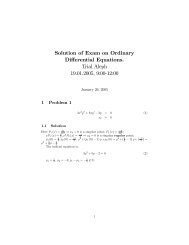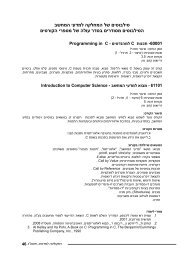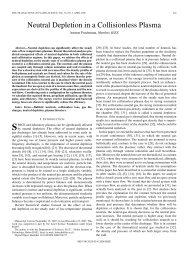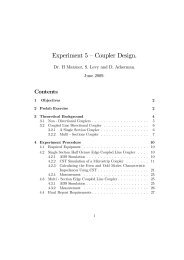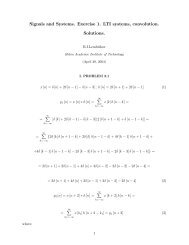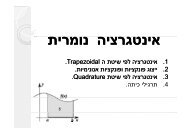Experiment 3 - Transmission Lines, Part 1
Experiment 3 - Transmission Lines, Part 1
Experiment 3 - Transmission Lines, Part 1
You also want an ePaper? Increase the reach of your titles
YUMPU automatically turns print PDFs into web optimized ePapers that Google loves.
<strong>Experiment</strong> 3 - <strong>Transmission</strong> <strong>Lines</strong>, <strong>Part</strong> 1<br />
Dr. Haim Matzner & Shimshon Levy.<br />
August, 2008.
Contents<br />
Introduction 1<br />
0.1 Prelab Exercise . . . . . . . . . . . . . . . . . . . . . . . . . . 1<br />
0.2 Background Theory . . . . . . . . . . . . . . . . . . . . . . . . 1<br />
0.2.1 Characteristic Impedance . . . . . . . . . . . . . . . . 5<br />
0.2.2 Terminated Lossless Line . . . . . . . . . . . . . . . . . 6<br />
0.2.3 The Impedance Transformation . . . . . . . . . . . . . 8<br />
0.3 Shorted <strong>Transmission</strong> Line . . . . . . . . . . . . . . . . . . . . 9<br />
0.3.1 Open Circuit Line- . . . . . . . . . . . . . . . . . . . . 12<br />
0.3.2 Low Loss Line . . . . . . . . . . . . . . . . . . . . . . . 12<br />
0.4 Calculating <strong>Transmission</strong> Line parameters by Measuring Z 0 , α, and<br />
β . . . . . . . . . . . . . . . . . . . . . . . . . . . . . . . . . . 13<br />
0.4.1 Calculating Coaxial Line Parameters by Measuring<br />
Physical Dimensions . . . . . . . . . . . . . . . . . . . 14<br />
<strong>Experiment</strong> Procedure 17<br />
0.5 Required Equipment . . . . . . . . . . . . . . . . . . . . . . . 17<br />
0.6 Phase Difference of Coaxial Cables, Simulation and Measurement<br />
. . . . . . . . . . . . . . . . . . . . . . . . . . . . . . . . 17<br />
0.7 Wavelength of Electromagnetic Wave in Dielectric Material . . 18<br />
0.8 Input Impedance of Short - Circuit <strong>Transmission</strong> Line . . . . . 20<br />
0.9 Impedance Along a Short - Circuit Microstrip <strong>Transmission</strong><br />
Line . . . . . . . . . . . . . . . . . . . . . . . . . . . . . . . . 22<br />
0.10 Final Report . . . . . . . . . . . . . . . . . . . . . . . . . . . . 24<br />
0.11 Appendix-1 - Engineering Information for RF Coaxial Cable<br />
RG-58 . . . . . . . . . . . . . . . . . . . . . . . . . . . . . . . 25<br />
v
Introduction<br />
0.1 Prelab Exercise<br />
• 1. Define the terms: Relative permittivity, dielectric loss tangent<br />
(tan δ), skin depth and distributed elements.<br />
2. Refer to Figure 1, find the frequency that will cause a 2π radians phase<br />
difference between the two RG-58 coaxial cables, assume µ R = 1, ɛ r = 2.3.<br />
a. Find the relative amplitude of the two signals.<br />
b. Verify your answers in the laboratory.<br />
Signal generator<br />
515.000,00 MHz<br />
0.7m RG-58<br />
Oscilloscope<br />
3.4m RG-58<br />
Figure 1 -Phase difference between two coaxial cables.<br />
0.2 Background Theory<br />
<strong>Transmission</strong> lines provide one media of transmitting electrical energy between<br />
the power source to the load. Figure 2 shows three different geometry<br />
types of lines used at microwave frequencies.<br />
1
2 CHAPTER 0 INTRODUCTION<br />
Coaxial cable<br />
Two paralel<br />
wire line<br />
Microstrip<br />
Line<br />
Figure 2 - Popular transmission lines.<br />
Rectangular metal<br />
waveguide<br />
The open two-wire line is the most popular at lower frequencies, especially<br />
for TV application. Modern RF and microwave devices practice involves<br />
considerable usage of coaxial cables at frequencies from about 10 MHz up to<br />
30 GHz and hollow waveguides from 1 to 300 GHz.<br />
A uniform transmission line can be defined as a line with distributed<br />
elements, as shown in Figure 3.<br />
R’ = Series resistance per unit length of line (Ω/m).<br />
Resistance is related to the dimensions and conductivity of the metallic<br />
conductors, resistance is depended on frequency due to skin effect.<br />
G’ = Shunt conductance per unit length of line (/m).<br />
G’ is related to the loss tangent of the dielectric material between the two<br />
conductors. It is important to remember that G’ is not a reciprocal of R’.<br />
They are independent quantities, R’ being related to the various properties<br />
of the two conductors while G’ is related to the properties of the insulating<br />
material between them.
0.2 BACKGROUND THEORY 3<br />
First section Second section Third-section<br />
R/2 L/2 L/2 R/2<br />
ZG<br />
G C G C G<br />
C<br />
Equivalent circuit of transmission line<br />
z=0<br />
Figure 3 -<strong>Transmission</strong> lines model<br />
L ’ = Series inductance per unit length of line (H/m).<br />
L’- Is associated with the magnetic flux between the conductors.<br />
C’ = Shunt capacitance per unit length of line (F/m).<br />
C’- Is associated with the charge on the conductors.<br />
Naturally, a relatively long piece of line would contain identical sections as<br />
shown. Since these sections can always be chosen to be small as compared to<br />
the operating wavelength. Hence the idea is valid at all frequencies. The series<br />
impedance and the shunt admittance per unit length of the transmission<br />
line are given by:<br />
Z = R ′ + JωL ′<br />
Y = G ′ + JωC ′<br />
The expressions for voltage and current per unit length are given respectively<br />
by equations (1) and (2):<br />
dV (z)<br />
dz<br />
dI(z)<br />
dz<br />
= −I(z)(R ′ + JωL ′ ) (1)<br />
= −V (z)(G ′ + JωC ′ ) (2)<br />
Where the negative sign indicates on a decrease in voltage and current as z<br />
increases. The current and voltage are measured from the receiving end; at<br />
z = 0 and line extends in negative z-direction. The differentiating equations,<br />
(3) and (4), associate the voltage and current:
4 CHAPTER 0 INTRODUCTION<br />
d 2 V (z)<br />
dz<br />
d 2 I(z)<br />
dz<br />
Where<br />
= −(R ′ + JωL ′ ) dI(z)<br />
dz<br />
= −(G ′ dV (z)<br />
+ JωC)<br />
dz<br />
= (G ′ + JωC ′ )(R ′ + JωL ′ )V (z) = γ 2 V (z) (3)<br />
= (G ′ + JωC ′ )(R ′ + JωL ′ )I(z) = γ 2 I(z)(4)<br />
γ = √ ZY = √ (G ′ + jωC ′ )(R ′ + jωL ′ ) (5)<br />
The above equations are known as wave equations for voltage and current,<br />
respectively, propagating on a line. The solutions of voltage and current<br />
waves are:<br />
V (z) = V 1 e −γz + V 2 e +γz (6)<br />
I(z) = I 1 e −γz + I 2 e +γz<br />
These solutions are shown as the sum of two waves; the first term ,V 1 , indicates<br />
the wave traveling in positive z-direction, and is called the incident<br />
wave, while the second term, V 2 , indicates the wave traveling in the negative<br />
z-direction, and is called the reflected wave. γ is a complex number that is<br />
called the propagation constant and can be defined as:<br />
γ = α + jβ (7)<br />
α is called the attenuation constant of the propagating wave, α is the real part<br />
of Eq. (2.7) while β is the imaginary part and is called the phase constant.<br />
Thus, propagation constant γ is the phase shift and attenuation per unit<br />
length along the line. Separating equation (2.5) into real and imaginary<br />
parts, we can get:<br />
α =<br />
β =<br />
[√<br />
(G<br />
′2<br />
+ ω 2 C 2 )(R ′2 + ω 2 L ′2 ) + (R ′ G ′ − ω 2 L ′ C ′ )<br />
[√<br />
(G<br />
′2<br />
+ ω 2 C ′2 )(R ′2 + ω 2 L ′2 ) − (R ′ G ′ − ω 2 L ′ C ′ )<br />
2<br />
2<br />
] 1<br />
2<br />
] 1<br />
2<br />
(8)<br />
(9)<br />
α is measured in nepers per unit length of the transmission line (1 neper<br />
= 8.686dB). β is measured in radians per unit length of tthe transmission
0.2 BACKGROUND THEORY 5<br />
line. That means that β can be calculated as:<br />
β = 2π λ<br />
(10)<br />
Where λ is the wavelength or distance along the line corresponding to a phase<br />
change of 2π radians. If the wavelength in free space is denoted by λ 0 , then:<br />
λ 0 = c = v √<br />
p ɛR µ R<br />
= λ √ ɛ R µ<br />
f 0 f<br />
R (11)<br />
Where c is the velocity of light in free space and v p is the velocity of electric<br />
wave in a dielectric material.<br />
0.2.1 Characteristic Impedance<br />
If RF voltage V is applied across the conductors of an infinite line, it causes a<br />
current I to flow. By this observation, the line is equivalent to an impedance,<br />
which is known as the characteristic impedance, Z 0 :<br />
Z 0 = V (z)<br />
I(z)<br />
The expression for current I, using Eqs. (2.1) and (2.6), is given by:<br />
Where<br />
1<br />
I = −<br />
(R ′ + JωL ′ )<br />
I 1 =<br />
∂V<br />
∂z = − 1<br />
(R ′ + JωL ′ ) (−γ)(V 1e −γz + V 2 e +γz )<br />
I(z) = I 1 e −γz + I 2 e +γz<br />
V 1<br />
(R ′ + JωL ′ ) (γ) and I 2 =<br />
V 2<br />
(R ′ + JωL ′ ) (γ)<br />
Infinite line has no reflection, therefore I 2 = V 2 = 0 and:<br />
V (z)<br />
I(z) = V 1<br />
I 1<br />
=<br />
(R ′ + JωL ′ )<br />
√<br />
(R′ + JωL ′ )(G ′ + JωC ′ )<br />
Thus the characteristic impedance of infinite line can be calculated by (12):<br />
√<br />
Z 0 = V (z)<br />
I(z) = (R ′ + JωL ′ )<br />
(12)<br />
(G ′ + JωC ′ )
6 CHAPTER 0 INTRODUCTION<br />
Line Impedance<br />
We can rewrite the current and voltange along the line as:<br />
V (z) = V 1 e −γz + V 2 e +γz (13)<br />
I(z) = V 1<br />
Z 0<br />
e −γz + V 2<br />
Z 0<br />
e +γz<br />
and the line impedance (the impedance at point z) as:<br />
Z(z) = V (z)<br />
I(z) = Z 0 (V 1 e −γz + V 2 e +γz )<br />
V 1 e −γz − V 2 e +γz (14)<br />
0.2.2 Terminated Lossless Line<br />
Consider a lossles line, length l, terminated with a load Z L , as shown in<br />
Figure 4.<br />
I(z)<br />
I L<br />
V(z)<br />
V L<br />
Z l<br />
z = −l<br />
l<br />
z<br />
=<br />
0<br />
Figure 4 - A transmission line, terminated with a load.<br />
Using equation (2.13) and recalling that α = 0, one can define the current<br />
and voltage on the load terminal (at z = 0) as:<br />
V L<br />
I L<br />
= Z L (15)<br />
V (z = 0) = V 1 e −jβ(0) + V 2 e jβ(0) = V 1 + V 2 (16)<br />
I(z = 0) = V 1<br />
Z 0<br />
e −jβ(0) − V 2<br />
Z 0<br />
e jβ(0) = V 1<br />
Z 0<br />
+ V 2<br />
Z 0
0.2 BACKGROUND THEORY 7<br />
We can also add the boundary conditions:<br />
V (z = 0) = V L (17)<br />
I(z = 0) = I L<br />
Using equation (2.16) we can rewrite (2.15) as equation (2.18):<br />
Z L = V L<br />
I L<br />
=<br />
V (z = 0)<br />
I(z = 0) = V 1 + V 2<br />
V 1<br />
Rearranging equation (2.18) one can rewrite:<br />
V 2<br />
Z 0<br />
+ V 2<br />
Z 0<br />
(18)<br />
= Z L − Z 0<br />
⊜ Γ<br />
V 1 Z L + Z 0<br />
Where Γ is the complex reflection coefficient. It relates to the magnitude and<br />
phase of the reflected wave (V 2 ) emerging from the load and to the magtitude<br />
and phase of the incident wave (V 1 ) , or<br />
Equation (2.13) can be rewrite as:<br />
V 2 = ΓV 1 (19)<br />
V (z) = V 1 e −jβz + ΓV 1 e jβz (20)<br />
I(z) = V 1<br />
Z 0<br />
e −jβz − Γ V 1<br />
Z 0<br />
e jβz<br />
The reflection coefficient at an arbitrary point along the transmission line is:<br />
Γ(z) = V 2e −jβz<br />
= Γ(0)e−2jβz<br />
V 1 e−jβz While the time average power flow along the line at point z is:<br />
P av = 1 2 Re[V (z)I(z)∗ ] (21)<br />
= 1 2<br />
V 2<br />
1<br />
Z 0<br />
Re ( 1 − Γ ∗ e −j2βz + Γe j2βz − |Γ| 2)<br />
When recalling that Z − Z ∗ = 2j Im Z, equation (2.21) can be simplified to:<br />
P av = 1 2<br />
V 2<br />
1<br />
Z 0<br />
(<br />
1 − |Γ|<br />
2 ) (22)<br />
Which shows that the average power flow is constant at any point on the<br />
lossless transmission line. If Γ = 0 (perfect match), the maximum power is<br />
delievered to the load, while all the power is reflected for Γ = 1.
8 CHAPTER 0 INTRODUCTION<br />
0.2.3 The Impedance Transformation<br />
According to the transmission line theory, in a short circuit line, the impedance<br />
become infinite at a distance of one-quarter wavelength from the<br />
short. The ability to change the impedance by adding a length of transmission<br />
line is a very important attribute to every RF or microwave designer.<br />
If we look at the transmission line (losseless line), as illustrated in Figure 5,<br />
and use equation (2.20), the line impedance at z = −l (input impedance)<br />
is:<br />
Z in =<br />
V (z = −l)<br />
I(z = −l) = Z 0<br />
( )<br />
e jβl + Γe −jβl<br />
e jβl − Γe −jβl<br />
(23)<br />
l<br />
I L<br />
I (z)<br />
ZG<br />
Z in<br />
Z 0<br />
β<br />
V L<br />
ZL<br />
z = −l<br />
z = 0<br />
Figure 5 -<strong>Transmission</strong> line terminated in arbitrary impedance Z L .<br />
If we use the relationship Γ = (Z L − Z 0 ) / (Z L + Z 0 ) with equation (2.23) we<br />
get:<br />
( (<br />
ZL e jβl + e −jβl) (<br />
+ Z 0 e jβl − e −jβl)<br />
)<br />
Z in = Z 0 (24)<br />
Z L (e jβl + Γe −jβl ) − Z 0 (e jβl − e −jβl )<br />
By recalling Euler’s equations:<br />
e jβl<br />
e −jβl<br />
= cos βl + j sin βl<br />
= cos βl − j sin βl<br />
We can get:<br />
( )<br />
ZL cos βl + jZ 0 sin βl<br />
Z in = Z 0<br />
Z 0 cos βl + jZ L sin βl<br />
Or:<br />
( )<br />
ZL + jZ 0 tan βl<br />
Z in = Z 0<br />
Z 0 + jZ L tan βl<br />
Lets examine special cases:<br />
(25)
0.3 SHORTED TRANSMISSION LINE 9<br />
0.3 Shorted <strong>Transmission</strong> Line<br />
The voltage and current along a transmission line as a function of time is<br />
known as:<br />
[<br />
V (z, t) = A cos ω<br />
(t − z ) ] [<br />
+ θ + B cos ω<br />
(t + z ) ]<br />
+ φ (26)<br />
v p v p<br />
I(z, t) = 1 [ {A cos ω<br />
(t − z ) ] [<br />
+ θ − B cos ω<br />
(t + z ) ]}<br />
+ φ<br />
Z 0 v p v p<br />
Where z = 0, at the generator side, and d = 0 at the load side, as shown in<br />
Figure 6.<br />
z=d<br />
z<br />
V<br />
Z 0<br />
I(z)<br />
, β<br />
z<br />
z=0<br />
Figure 6 -Shorted transmission line.<br />
This expression can be rewrite in phasor form as:<br />
V (z) = V 1 e −jβz + V 2 e jβz (27)<br />
I(z) =<br />
1 (<br />
V1 e −jβz − V 2 e jβz)<br />
Z 0<br />
Where V 1 = Ae jθ is the forward wave, V 2 = Be jϕ is the reflected wave and<br />
β = ω/v p .The boundary condition for the short circuit transmission line at<br />
z = 0 is that the voltage across the short circuit is zero:<br />
Using equations (27) and (28), we obtain:<br />
V (0) = 0 (28)
10 CHAPTER 0 INTRODUCTION<br />
V (0) = V 1 e jβ0 + V 2 e −jβ0 = 0 (29)<br />
V 1 = −V 2<br />
Inserting Eq (29) into Eq (28), we get:<br />
V (z) = V 1 e jβz − V 1 e −jβz = 2jV 1 sin βz (30)<br />
I(z) = 1 Z 0<br />
(<br />
V1 e jβz + V 1 e −jβz) = 2 V 1<br />
Z 0<br />
cos βz<br />
Which shows that the V = 0 at the load end, while the current is a maximum<br />
there. The ratio between V(z) and I(z) is the input impedance and is equal<br />
to:<br />
Z in = jZ 0 tan βz (31)<br />
Which is purely imaginary for any length of z. The value of Z in(sc) vary<br />
between +j∞ to −j∞, every π/2 (λ/4),by changing z, the length of the<br />
line, or by changing the frequency. The voltage and current as a function of<br />
time and distance are:<br />
V (z, t) = Re [ V (z)e jωt] (32)<br />
= Re ( 2e jπ/2 |V 1 | e jθ e jωt sin βz )<br />
= −2 |V 1 | sin βz sin (ωt + θ)<br />
Where V 1 = |V 1 | e jθ and j = e jπ/2 .<br />
I(z, t) = Re [ I(z)e jωt] (33)<br />
(<br />
= Re 2 V )<br />
1<br />
cos βze jωt<br />
Z 0<br />
2<br />
= |V 1 | cos βz cos (θ + ωt)<br />
Z 0
0.3 SHORTED TRANSMISSION LINE 11<br />
Figure 7 -Voltage along a shorted transmission line, as a function of time<br />
and distance from the load. Frequency 1GHz.<br />
The result of the voltage on the shorted transmission line is shown in<br />
figure 7, assume that V 1 = sin 2π10 9 t (λ = 30cm) , which shows that :<br />
• The line voltage is zero for βz = 0 + nπ n = 0, 1, 2...for all value of<br />
time.<br />
• The voltage at every point of z is sinusoidal as a function of time. The<br />
maximum absolute value of the voltage is known as a standing wave<br />
pattern.<br />
Impedance<br />
magnitude<br />
Frequency difference<br />
0 Wavelengths 1 (λ)<br />
2<br />
Figure 8 - Input impedance of shorted low loss coaxial cable.
12 CHAPTER 0 INTRODUCTION<br />
0.3.1 Open Circuit Line-<br />
For lossless line α ≠ 0 and Y L = 0, equation (2.25) is reduce to:<br />
or in impedance form:<br />
Y in = Y 0 tan βz<br />
Z in(os) = Z 0<br />
tan βz<br />
(34)<br />
Using Eqs. (2.24), (2.34) and (2.35), Z 0 can be computed from the short and<br />
open circuit, by the relation:<br />
Z 0 = √ Z in(sc) Z in(os)<br />
0.3.2 Low Loss Line<br />
In many cases, the loss of microwave transmission lines is small. In these<br />
cases, some approximation can be made that simplify the expression of propagation<br />
constant γ and characteristic impedance Z 0 .Equation (5) can be rearranged<br />
as:<br />
γ =<br />
√<br />
(jωC ′ jωL ′ )(1 + R′<br />
jωL ′ ) (<br />
1 + G′<br />
jωC ′ )<br />
= jω √ L ′ C ′ √1 − j<br />
( R<br />
′<br />
ωL ′ + G′<br />
ωC ′ )<br />
− R′ G ′<br />
ω 2 L ′ C ′<br />
(35)<br />
If we assume that R ′
0.4 CALCULATING TRANSMISSION LINE PARAMETERS BY MEASURING Z 0 , α,<br />
so Re γ = α− is the attenuation constant and Im γ = β−phase constant,<br />
therefore:<br />
(<br />
α ≈ 1 √ √ )<br />
C<br />
R ′ ′ L<br />
+ G ′ ′<br />
(37)<br />
2 L ′ C ′<br />
= 1 ( )<br />
R<br />
′<br />
+ G ′ Z 0 = α c + α d<br />
2 Z 0<br />
Where α c is the conductor loss and α d is the dielectric loss. The phase<br />
constant is equal to:<br />
√<br />
β ≈ ω √ L ′ C ′ (38)<br />
L<br />
Where Z 0 =<br />
.<br />
C ′<br />
Note that the characteristic impedance of a low loss transmission line can<br />
be approximated by:<br />
Z 0 =<br />
√<br />
(R ′ + JωL ′ )<br />
(G ′ + JωC ′ ) ≈ √<br />
L<br />
′<br />
C ′<br />
0.4 Calculating <strong>Transmission</strong> Line parameters<br />
by Measuring Z 0 , α, and β<br />
By knowing the primary parameters Z 0 , α,and β, the equivalent parameters<br />
R, L, C and G can be extracted by multiplying the general expressions of Z 0<br />
and γ :<br />
R ′ + jωL ′<br />
= Z 0 γ<br />
= (R 0 + jx 0 )(α + jβ)<br />
= (R 0 α − x 0 β) + j(R 0 β + x 0 α) (39)<br />
Where R 0 is the real part of Z 0 and x 0 is its imaginary part. By Equating<br />
the real and imaginary part we get:<br />
R ′ = R 0 α − x 0 β Ω m<br />
(40)<br />
and:<br />
L ′ = R 0β + x 0 α<br />
ω<br />
H<br />
m<br />
(41)
14 CHAPTER 0 INTRODUCTION<br />
By dividing the general expressions of Z 0 and γ,we get<br />
G ′ + JωC ′<br />
= γ Z 0<br />
(42)<br />
= α + jβ ∗ R 0 − jx 0<br />
R 0 + jx 0 R 0 − jx 0<br />
= R 0α + x 0 β<br />
R0 2 + + j R 0β − x 0 α<br />
x2 0 R 2 0 + x2 0<br />
By equating real and imaginary parts, we get:<br />
(43)<br />
and:<br />
G ′ = R 0α + x 0 β<br />
R 2 0 + x 2 0<br />
C ′ = R 0β − x 0 α<br />
(R 2 0 + x 2 0)ω<br />
(44)<br />
(45)<br />
0.4.1 Calculating Coaxial Line Parameters by Measuring<br />
Physical Dimensions<br />
Referring to Figure 9, if the center conductor is charged to +q and the outer<br />
conductor (shielding) is charged to −q, than the electric field lines will directe<br />
radially outward, while the magnetic lines will surround the inner conductor.<br />
Dielectric<br />
material<br />
z=0<br />
l<br />
z=l<br />
magnetic field lines<br />
b<br />
E field lines<br />
a<br />
Figure 9 - Geometry and elemagnetic fields lines of coaxial cable.<br />
By applying Gauss law to a cylindrical structure like a coaxial cable of length<br />
l and radius r, where a < r > b:<br />
∫ l ∫ 2π<br />
0 0<br />
Drdφdz = q
0.4 CALCULATING TRANSMISSION LINE PARAMETERS BY MEASURING Z 0 , α,<br />
D is independent of z and φ therefore:<br />
D =<br />
q<br />
2πrl and E =<br />
The voltage difference between the conductors:<br />
V = −<br />
∫ b<br />
a<br />
E.dr =<br />
q<br />
2πɛ 0 ɛ r rl<br />
q<br />
2πɛ 0 ɛ r l ln b a<br />
Hence:<br />
C = q V = 2πɛ 0ɛ r l<br />
(46)<br />
ln b a<br />
All dielectric materials have lossy at microwave frequencies. Hence one can<br />
look at a coaxial cable as a capacitor with parallel conductance or<br />
The quantity j G<br />
ωC<br />
Y = G + jωC = jωC(1 − j G<br />
ωC )<br />
called material loss tangent and assign as tan δ. This<br />
quantity indicates the relative magnitude of the loss component. It is often<br />
used to specify the loss properties of dielectrics:<br />
G = jωCtanδ = 2πɛ 0ɛ r l<br />
ωtanδ (47)<br />
ln b a<br />
Inductance of <strong>Transmission</strong> line<br />
The inductance of solenoid known as<br />
L = NΦ<br />
I<br />
(48)<br />
Flux<br />
φ<br />
Area- A<br />
l<br />
N turns<br />
r<br />
Current I<br />
Figure 10 -Inductance of solenoid.
16 CHAPTER 0 INTRODUCTION<br />
where N is the number of turns, l is the length and I is the current in the<br />
solenoid. Applying ampere law to a circle radius r (b < r > a) around any<br />
turn of the solenoid will result in:<br />
H = I<br />
2πr<br />
I<br />
r<br />
H=<br />
Magnetic field arround<br />
current carrying conductor<br />
I<br />
2 π r<br />
H<br />
Magnetic flux between the<br />
conductor<br />
Figure 11 -Magnetic field around conductor and solenoid.<br />
If one wants to measure the total flux between the conductors, it’s the flux<br />
enter the turn shown in Figure10 and Figure11. Therefore<br />
Φ =<br />
∫ l<br />
∫ b<br />
0<br />
a<br />
Bdrdz = µ 0 µ r l<br />
∫ b<br />
a<br />
I<br />
2πr dr = µ 0µ R lI<br />
ln b 2π a<br />
Coaxial cable could be considered as a solenoid with one turn.<br />
equation 1.50, the expression for Φ and N=1 becomes:<br />
L = µ 0µ R l<br />
2π<br />
ln b a<br />
By using<br />
(49)<br />
Resistance of <strong>Transmission</strong> Line<br />
The high frequency resistance of a coaxial cable is equal to the D.C.<br />
resistance of a equivalent coaxial cable composed of two hollow conductors<br />
with the radii, a and b, respectively, and with thickness equal to the skin<br />
depth penetration δ. Skin depth penetration is defined as<br />
δ skin =<br />
1<br />
√<br />
πfµ0 µ R σ meters<br />
Where σ is the conductivity of the conductor. Therefore the resistance<br />
per unit length is:<br />
R ′ =<br />
1<br />
2πaδ skin σ + 1<br />
2πbδ skin σ =<br />
b + a<br />
2πaδ skin σb<br />
(50)
<strong>Experiment</strong> Procedure<br />
0.5 Required Equipment<br />
1. Network Analyzer HP − 8714B.<br />
2. Arbitrary Waveform Generators (AW G)HP − 33120A.<br />
3. Agilent ADS software.<br />
4. Termination-50Ω .<br />
5. Standard 50Ω coaxial cable .<br />
6. Open Short termination.<br />
7. SMA short termination.<br />
8. 50 cm 50Ω FR4 microstrip line<br />
0.6 Phase Difference of Coaxial Cables, Simulation<br />
and Measurement<br />
In this part of the experiment you will verify your answers to the prelab<br />
exercise.<br />
Signal generator<br />
515.000,00 MHz<br />
0.7m RG-58<br />
Oscilloscope<br />
3.4m RG-58<br />
Figure 1 - Phase difference between two coaxial cables<br />
17
18 CHAPTER 0 EXPERIMENT PROCEDURE<br />
1. Simulate the system as indicated in Figure 2 (see also Figure 1).<br />
S-PARAMETERS<br />
S_Param<br />
SP1<br />
Start=1.0 MHz<br />
Stop=100 MHz<br />
Step=1.0 MHz<br />
PwrSplit2<br />
PWR1<br />
S21=0.707<br />
P_AC<br />
S31=0.707<br />
PORT1<br />
Num=1<br />
Z=50 Ohm<br />
Pac=polar(dbmtow(0),0)<br />
Freq=freq<br />
COAX<br />
TL1<br />
Di=0.9 mm<br />
Do=2.95 mm<br />
L=3400 mm<br />
Er=2.29<br />
TanD=0.0004<br />
Rho=1<br />
COAX<br />
TL2<br />
Di=0.9 mm<br />
Do=2.95 mm<br />
L=700 mm<br />
Er=2.29<br />
TanD=0.0004<br />
Rho=1<br />
Term<br />
Term2<br />
Num=2<br />
Z=50 Ohm<br />
Term<br />
Term3<br />
Num=3<br />
Z=50 Ohm<br />
Figure 2 - Phase Difference Simulation.<br />
2. Plot S 21 (phase) and S 31 (phase) on the same graph, find the frequency<br />
where the phases of the two cables are equal. Save the data.<br />
Compare this frequency to the frequency you calculated in the prelab<br />
exercise.<br />
3. Connect coaxial cables to a oscilloscope using power splitter, as indicated<br />
in Figure 1.<br />
4. Set the signal generator to the frequency according to your simulation,<br />
and verify that the phase difference is near 0 degree. Save the data on<br />
magnetic media.<br />
0.7 Wavelength of Electromagnetic Wave in<br />
Dielectric Material<br />
1. Select a 50 cm length FR4 microstrip line, W idth = 3mm, Height =<br />
1.6mm, ɛ r = 4.6, Z 0 = 50Ω, , v p = 0.539c, ɛ eff = 3.446.
0.7 WAVELENGTH OF ELECTROMAGNETIC WAVE IN DIELECTRIC MATERIAL<br />
microstrip length 50cm<br />
Figure 3 - 50 cm short circuit microstrip line.<br />
2. Calculate the frequency that half the wavelength in the dielectric<br />
material is equal to 50 cm (λ/2 = 50cm). Record this frequency.<br />
Verify your answer using ADS: Menu -> Tools -> LineCalc.<br />
MSub<br />
TRANSIENT<br />
PARAMETER SWEEP<br />
MSUB<br />
MSub1<br />
H=1.6 mm<br />
Er=4.7<br />
Mur=1<br />
Cond=1.0E+50<br />
Hu=1.0e+033 mm<br />
T=17 um<br />
TanD=0.01<br />
Rough=0 mm<br />
Tran<br />
Tran1<br />
StopTime=26 nsec<br />
MaxTimeStep=0.1 nsec<br />
Var<br />
Eqn<br />
VAR<br />
VAR1<br />
x=26<br />
ParamSweep<br />
Sweep1<br />
SweepVar="x"<br />
SimInstanceName[1]="Tran1"<br />
SimInstanceName[2]=<br />
SimInstanceName[3]=<br />
SimInstanceName[4]=<br />
SimInstanceName[5]=<br />
SimInstanceName[6]=<br />
Start=0<br />
Stop=50<br />
Step=1<br />
P_1Tone<br />
PORT1<br />
MLIN<br />
Num=1<br />
TL1<br />
Z=50 Ohm Subst="MSub1"<br />
P=polar(dbmtow(0),0) W=3 mm<br />
Freq=161 MHz L=x cm<br />
I_Probe<br />
I_Probe1<br />
MLIN<br />
TL2<br />
Subst="MSub1"<br />
W=3 mm<br />
L=(50-x) cm<br />
Term<br />
Term2<br />
Num=2<br />
Z=0.0001 mOhm<br />
Figure 4 - Simulation of short sircuit microstrip transmission line.
20 CHAPTER 0 EXPERIMENT PROCEDURE<br />
3. Simulate a short circuit λ/2 microstrip line according to Figure 4.<br />
Draw a graph of the current as a function of time.<br />
Explain the graph.<br />
Find the distance where the current amplitude is minimum all the time.<br />
Find the time where the current amplitude is minimum at every point on<br />
the microstrip line. Save the data.<br />
4. Find the position where the current amplitude is maximum and change<br />
the simulation accordingly.<br />
Draw a graph of the current as a function of time to prove your answer.<br />
Save the data.<br />
5. Find the position where the current amplitude is minimum. Draw a<br />
graph of the current as a function of time to prove your answer. Save the<br />
data.<br />
6. Connect the short circuit microstrip line to a signal generator, adjust<br />
the frequency to the calculated frequency and the amplitude to 0 dBm.<br />
7. Measure the amplitude of the signal, using wideband oscilloscope at<br />
load end and signal generator end, why the amplitude of the signal at both<br />
ends is close to 0 volt.<br />
8. Measure the voltage along the line using the probe of the oscilloscope,<br />
verify that the voltage is maximum at the middle of the line.<br />
9. Calculate the frequency for λ = 50 cm in the dielectric material.<br />
Measure the voltage along the line, how many points of maximum voltage<br />
exist along the line?<br />
0.8 Input Impedance of Short - Circuit <strong>Transmission</strong><br />
Line<br />
1. Simulate a transmission line terminated by a short circuit, as shown in<br />
Figure 5.
0.8 INPUT IMPEDANCE OF SHORT - CIRCUIT TRANSMISSION LINE21<br />
S-PARAMETERS<br />
Zin<br />
N<br />
Zin<br />
Zin1<br />
Zin1=zin(S11,PortZ1)<br />
Term<br />
Term1<br />
Num=1<br />
Z=50 Ohm<br />
Var<br />
Eqn<br />
COAX<br />
TL1<br />
Di=2 mm<br />
Do=4.6 mm<br />
L=70 mm<br />
Er=1<br />
TanD=0.002<br />
Rho=1<br />
VAR<br />
VAR1<br />
X=1.0<br />
S_Param<br />
SP1<br />
Freq=642 MHz<br />
COAX<br />
TL2<br />
Di=2 mm<br />
Do=4.6 mm<br />
L=X<br />
Er=1<br />
TanD=0.002<br />
Rho=1<br />
PARAMETER SWEEP<br />
ParamSweep<br />
Sweep1<br />
SweepVar="X"<br />
SimInstanceName[1]="SP1"<br />
SimInstanceName[2]=<br />
SimInstanceName[3]=<br />
SimInstanceName[4]=<br />
SimInstanceName[5]=<br />
SimInstanceName[6]=<br />
Term Start=0<br />
Term2 Stop=30<br />
Num=2 Step=0.25<br />
Z=0.0001 mOhm<br />
Figure 5 - Input impedance of a short circuit coaxial transmission line.<br />
2. Draw a graph of Z in as a function of length x, save the data.<br />
3. If you use fix length of transmission line, which parameter of the<br />
simulation you have to change in order to get the same variation of Z in ,<br />
prove your answer by simulation.<br />
4. Connect line stretcher terminated in a short circuit to a network analyzer<br />
(see Figure 6).
22 CHAPTER 0 EXPERIMENT PROCEDURE<br />
R F<br />
O UT<br />
R F<br />
IN<br />
Coaxial line<br />
strecher<br />
Short<br />
Figure 6 - Input impedance measurment of short circuit coaxial<br />
transmission line.<br />
5. Calculate the frequency for the wavelength 1.5λ = 70cm (line stretcher<br />
at minimum overall length).<br />
6. Set the network analyzer to smith chart format and find the exact<br />
frequency (around the calculated frequency) for the input impedance Z in =<br />
0.(line stretcher at minimum overall length), set the network analyzer to CW<br />
frequency equal to this measured frequency.<br />
7. Stretch the line and analyze the impedance in a smith chart.<br />
0.9 Impedance Along a Short - Circuit Microstrip<br />
<strong>Transmission</strong> Line<br />
1. Simulate a short circuit transmission line (see Figure 7) with length 50cm,<br />
width 3mm, height 1.6 mm and dielectric material FR4 ɛ ef f = 3.446.
0.9 IMPEDANCE ALONG A SHORT - CIRCUIT MICROSTRIP TRANSMISSION LIN<br />
PARAMET ER SW EEP<br />
ParamSweep<br />
Sweep1<br />
SweepVar=" x"<br />
SimInstanceName[1]=" SP1"<br />
SimInstanceName[2]=<br />
SimInstanceName[3]=<br />
SimInstanceName[4]=<br />
SimInstanceName[5]=<br />
SimInstanceName[6]=<br />
Start=0<br />
Stop=50<br />
Step=0.5<br />
Var<br />
Eqn<br />
VAR<br />
VAR1<br />
x=0<br />
Term<br />
Term1<br />
Num=1<br />
Z=50 Ohm<br />
S-PARAMET ERS<br />
S_Param<br />
SP1<br />
Freq=161 MHz<br />
MLIN<br />
TL2<br />
Subst=" MSub1"<br />
W =3 mm<br />
L=x cm<br />
MLIN<br />
TL1<br />
Subst=" MSub1"<br />
W =3 mm<br />
L=(50-x) cm<br />
Zin<br />
N<br />
Zin<br />
Zin1<br />
Zin1=zin(S11,PortZ1)<br />
Term<br />
Term2<br />
Num=2<br />
Z=0.001 mOhm<br />
Term<br />
Term3<br />
Num=3<br />
Z=100 MOhm<br />
MSub<br />
MSUB<br />
MSub1<br />
H=1.6 mm<br />
Er=4.7<br />
Mur=1<br />
Cond=1.0E+50<br />
Hu=1.0e+033 mm<br />
T=0 mm<br />
TanD=0.002<br />
Rough=0 mm<br />
Figure 7 - Simulation of a short and open circuit microstrip transmission<br />
lines.<br />
Pay attention that the simulation is parametric (x is the distance parameter).<br />
Verify thet for x ≠ λ/2 the input impedance is a superposition of a short<br />
and an open circuit transmission line connected in parallel and explain why<br />
is this so.<br />
2. Draw a graph of the input impedance as a function of the distance x.<br />
Save the data.<br />
3. Connect the microstrip to the network analyzer (as shown in Figure<br />
8), set the network analyzer to impedance magnitude measurement.
24 CHAPTER 0 EXPERIMENT PROCEDURE<br />
0<br />
λ / 8<br />
Open Short and Load Calibration<br />
RF<br />
OUT<br />
RF<br />
IN<br />
λ / 2<br />
microstrip length 50cm<br />
3<br />
λ<br />
8<br />
λ / 4<br />
Figure 8 - Measurement of input impedance of short circuit microstrip<br />
transmission line<br />
4. Set the network analyzer to Continuos Wave (CW), at the calculated<br />
frequency for λ/2 = 50cm.Calibrate the network analyzer to 1 port (reflection)<br />
at the end of the cable.<br />
4. What is the expected value of the impedance at each point?<br />
Measure the impedance magnitude at λ/2, 3λ/8, λ/4, λ/8, 0. Save the<br />
data on magnetic media.<br />
0.10 Final Report<br />
1. Attach and explain all the simulation graphs.<br />
2. Using MATLAB, draw a 3D graph of the current as a function of<br />
time and distance of a short circuit microstrip line for a frequency of 1GHz<br />
(similar to Figure 7 from chapter 1). Choose the ranges of time and distance<br />
as you wish and attach the matlab code.<br />
3. Using MATLAB, draw a graph of the input impedance, Z 0 , as a<br />
function of the length, x, for a lossless short circuit coaxial line for a frequency<br />
of 161 MHz. Compare this graph to your measurement and ADS simulation.<br />
Attach the matlab code.<br />
4. Using the physical dimension of a coaxial cable RG-58 that you measured,<br />
find the following parameters versus frequency (if apply) and draw a<br />
graph of:<br />
a. Shunt capacitance C per meter.<br />
b. Series inductance L per meter.<br />
c. Series resistance R per meter.<br />
d. Shunt conductance G per meter.
0.11 APPENDIX-1 - ENGINEERING INFORMATION FOR RF COAXIAL CABLE RG<br />
0.11 Appendix-1 - Engineering Information<br />
for RF Coaxial Cable RG-58<br />
Component<br />
Construction details<br />
Nineteen strands of tinned copper wire.<br />
Inner conductor each strand 0.18 mm diameter<br />
Overall diameter: 0.9 mm.<br />
Dielectric core Type A-1: Solid polyethylene.<br />
Diameter: 2.95 mm<br />
Outer conductor Single screened of tinned cooper wire.<br />
Diameter: 3.6 mm .<br />
Jacket Type lla: PVC.<br />
Diameter: 4.95mm.<br />
Engineering Information:<br />
Impedance: 50Ω<br />
Continuous working voltage; 1,400 V RMS, maximum.<br />
Operating frequency: 1 GHz, maximum.<br />
Velocity of propagation: 66% of speed light.<br />
Dielectric constant of polyethylene: 2.29<br />
Dielectric loss tangents of polyethylene: tan δ = 0.0004<br />
Operating temperature range: -40 C to +85 C.<br />
Capacitance: 101 pF . m
26 CHAPTER 0 EXPERIMENT PROCEDURE<br />
Attenuation of 100m Rg.-58 coaxial cable<br />
Attenuation (dB)<br />
70<br />
60<br />
50<br />
40<br />
30<br />
20<br />
10<br />
0<br />
y = 1 .292 + 1.537 f + 0. 0157 f<br />
0 200 400 600 800 1000<br />
Frequency(MHz)<br />
Figure 9 - Attenuation versus frequency of a coaxial cable RG-58.


